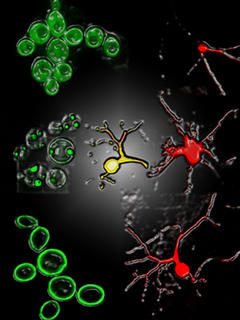PROGRAMA GULBENKIAN INCENTIVA INVESTIGAÇÃO DE FRONTEIRA EM CIÊNCIAS DA VIDA
PROGRAMA GULBENKIAN INCENTIVA INVESTIGAÇÃO DE FRONTEIRA EM CIÊNCIAS DA VIDA
O Programa Gulbenkian de Apoio à Investigação na Fronteira das Ciências da Vida vai financiar com 50 mil euros dois projectos nesta área. O Júri do prémio elegeu a proposta de investigação de Hélder Maiato, do Instituto de Biologia Molecular e Celular, no Porto, e de Tiago Fleming Outeiro, do Instituto de Medicina Molecular, em Lisboa.
Este programa tem como objectivo apoiar a originalidade e o desenvolvimento de novas ideias criativas no trabalho de investigação nas ciências da vida (cutting-edge research). Resultou da vontade de induzir nos centros de excelência a capacidade de apostar e arriscar nos investigadores mais jovens, em áreas de fronteira.
Hélder Maiato vai analisar a “Aplicação de microscopia de fluorescência de partículas (speckles) e microcirurgia laser para o estudo dos mecanismos de produção de força responsáveis pelo movimento dos cromossomas”. O investigador principal no Instituto de Biologia Molecular e Celular no Porto quer compreender como é que determinadas estruturas e moléculas contribuem para os mecanismos de geração de força responsáveis pelo movimento dos cromossomas durante a divisão celular. A correcta distribuição dos cromossomas entre duas células que se dividem é um requisito absolutamente necessário para a vida, e falhas neste processo estão na base de várias anomalias congénitas, como o síndrome de Down (trissomia 21). Estas falhas são também características de vários tipos de cancro em humanos.
Hélder Maiato, doutorou-se em 2003 no Instituto de Ciências Biomédicas Abel Salazar, da Universidade do Porto.
Tiago Fleming Outeiro, investigador principal no Instituto de Medicina Molecular em Lisboa, investigará “O Envolvimento Molecular da Proteina DJ-1 na Etiologia da Doença de Parkinson”. O cientista vai procurar a etiologia da perda neuronal selectiva que causa a doença, nomeadamente estudando a proteína DJ-1, codificada pelo gene PARK7. A função normal da DJ-1 é ainda desconhecida, mas pensa-se que o seu envolvimento na doença se deva a defeitos na sua função normal, causados por mutações. Um trabalho que poderá permitir a identificação de novas vias envolvidas na Doença de Parkinson, e assim contribuir para o desenvolvimento de novas terapêuticas para doenças neurodegenerativas.
Tiago Fleming Outeiro doutorou-se em 2004 no Whitehead Institute for Biomedical Research, MIT, Cambridge, EUA.
